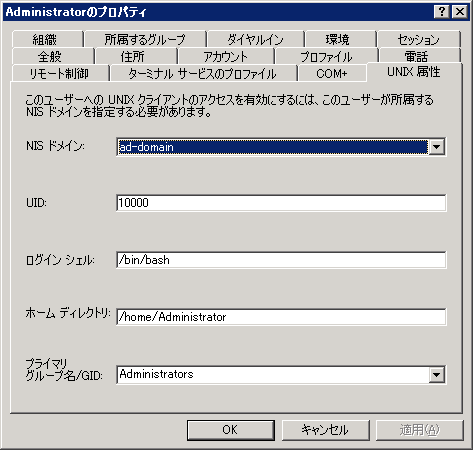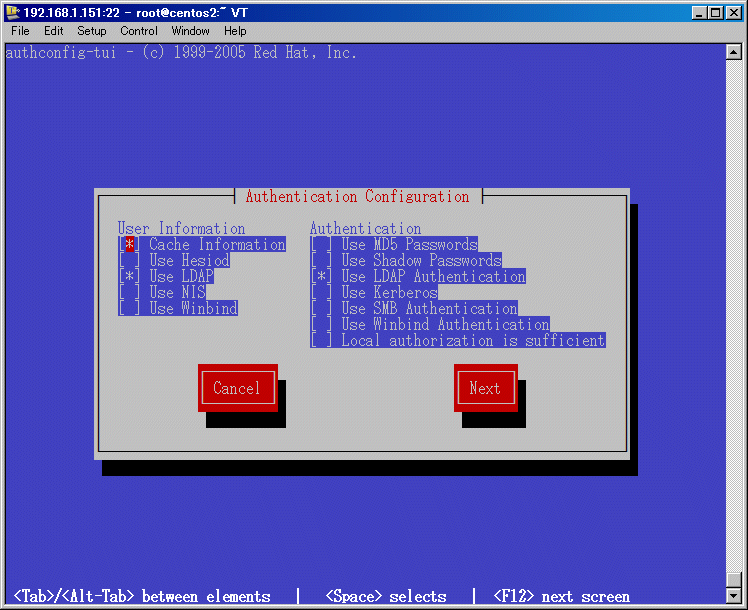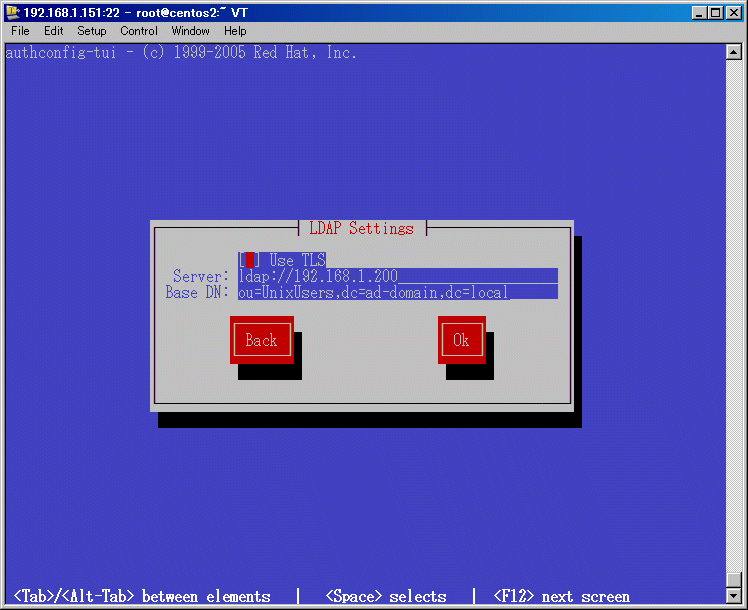●ActiveDictoryのスキーマ拡張
ActiveDirectoryに登録しているユーザをLinuxのアカウントとして利用できるよう設定します。ここではWindows2003 Server Standardを対象としています。標準のActiveDirectoryではUNIX属性が設定できませんのでSFU(Windows Service for UNIX)をインストールしスキーマを拡張する必要があります。
上記サイトよりダウンロード可能です。画面に従ってボタンをクリックしていけば良いのですが途中のコンポーネント選択の画面で以下の2つを選択しその他は外しておきます。
- NISサーバ
- パスワード同期
インストールが完了すると再起動を促されますので、従って再起動します。再起動後、ActiveDirectoryのユーザのプロパティで以下が追加されているのを確認します。

上記のようにUNIX属性を設定すれば準備完了です。
●Linux側の設定変更
# authconfig-tui
  |
●ldap.confの設定
上記のauthconfig-tuiにて/etc/ldap.confが修正されますが、これだけでは足りませんので手動で修正を追加します。
# @(#)$Id: ldap.conf,v 1.38 2006/05/15 08:13:31 lukeh Exp $
#
# This is the configuration file for the LDAP nameservice
# switch library and the LDAP PAM module.
#
# The man pages for this file are nss_ldap(5) and pam_ldap(5)
#
# PADL Software
# http://www.padl.com
#
# Your LDAP server. Must be resolvable without using LDAP.
# Multiple hosts may be specified, each separated by a
# space. How long nss_ldap takes to failover depends on
# whether your LDAP client library supports configurable
# network or connect timeouts (see bind_timelimit).
#host 192.168.1.200
# The distinguished name of the search base.
base ou=UnixUsers,dc=ad-domain,dc=local
# Another way to specify your LDAP server is to provide an
# uri with the server name. This allows to use
# Unix Domain Sockets to connect to a local LDAP Server.
#uri ldap://127.0.0.1/
#uri ldaps://127.0.0.1/
#uri ldapi://%2fvar%2frun%2fldapi_sock/
# Note: %2f encodes the '/' used as directory separator
# The LDAP version to use (defaults to 3
# if supported by client library)
#ldap_version 3
# The distinguished name to bind to the server with.
# Optional: default is to bind anonymously.
binddn cn=Administrator,cn=Users,dc=ad-domain,dc=local
# The credentials to bind with.
# Optional: default is no credential.
bindpw *******
# The distinguished name to bind to the server with
# if the effective user ID is root. Password is
# stored in /etc/ldap.secret (mode 600)
#rootbinddn cn=manager,dc=example,dc=com
# The port.
# Optional: default is 389.
#port 389
# The search scope.
#scope sub
#scope one
#scope base
# Search timelimit
#timelimit 30
timelimit 120
# Bind/connect timelimit
#bind_timelimit 30
bind_timelimit 120
# Reconnect policy: hard (default) will retry connecting to
# the software with exponential backoff, soft will fail
# immediately.
#bind_policy hard
# Idle timelimit; client will close connections
# (nss_ldap only) if the server has not been contacted
# for the number of seconds specified below.
#idle_timelimit 3600
idle_timelimit 3600
# Filter to AND with uid=%s
#pam_filter objectclass=account
# The user ID attribute (defaults to uid)
#pam_login_attribute uid
# Search the root DSE for the password policy (works
# with Netscape Directory Server)
#pam_lookup_policy yes
# Check the 'host' attribute for access control
# Default is no; if set to yes, and user has no
# value for the host attribute, and pam_ldap is
# configured for account management (authorization)
# then the user will not be allowed to login.
#pam_check_host_attr yes
# Check the 'authorizedService' attribute for access
# control
# Default is no; if set to yes, and the user has no
# value for the authorizedService attribute, and
# pam_ldap is configured for account management
# (authorization) then the user will not be allowed
# to login.
#pam_check_service_attr yes
# Group to enforce membership of
#pam_groupdn cn=PAM,ou=Groups,dc=example,dc=com
# Group member attribute
#pam_member_attribute uniquemember
# Specify a minium or maximum UID number allowed
#pam_min_uid 0
#pam_max_uid 0
# Template login attribute, default template user
# (can be overriden by value of former attribute
# in user's entry)
#pam_login_attribute userPrincipalName
#pam_template_login_attribute uid
#pam_template_login nobody
# HEADS UP: the pam_crypt, pam_nds_passwd,
# and pam_ad_passwd options are no
# longer supported.
#
# Do not hash the password at all; presume
# the directory server will do it, if
# necessary. This is the default.
#pam_password clear
# Hash password locally; required for University of
# Michigan LDAP server, and works with Netscape
# Directory Server if you're using the UNIX-Crypt
# hash mechanism and not using the NT Synchronization
# service.
#pam_password crypt
# Remove old password first, then update in
# cleartext. Necessary for use with Novell
# Directory Services (NDS)
#pam_password clear_remove_old
#pam_password nds
# RACF is an alias for the above. For use with
# IBM RACF
#pam_password racf
# Update Active Directory password, by
# creating Unicode password and updating
# unicodePwd attribute.
#pam_password ad
# Use the OpenLDAP password change
# extended operation to update the password.
#pam_password exop
# Redirect users to a URL or somesuch on password
# changes.
#pam_password_prohibit_message Please visit http://internal to change your password.
# RFC2307bis naming contexts
# Syntax:
# nss_base_XXX base?scope?filter
# where scope is {base,one,sub}
# and filter is a filter to be &'d with the
# default filter.
# You can omit the suffix eg:
# nss_base_passwd ou=People,
# to append the default base DN but this
# may incur a small performance impact.
#nss_base_passwd ou=People,dc=example,dc=com?one
#nss_base_shadow ou=People,dc=example,dc=com?one
#nss_base_group ou=Group,dc=example,dc=com?one
#nss_base_hosts ou=Hosts,dc=example,dc=com?one
#nss_base_services ou=Services,dc=example,dc=com?one
#nss_base_networks ou=Networks,dc=example,dc=com?one
#nss_base_protocols ou=Protocols,dc=example,dc=com?one
#nss_base_rpc ou=Rpc,dc=example,dc=com?one
#nss_base_ethers ou=Ethers,dc=example,dc=com?one
#nss_base_netmasks ou=Networks,dc=example,dc=com?ne
#nss_base_bootparams ou=Ethers,dc=example,dc=com?one
#nss_base_aliases ou=Aliases,dc=example,dc=com?one
#nss_base_netgroup ou=Netgroup,dc=example,dc=com?one
# Just assume that there are no supplemental groups for these named users
nss_initgroups_ignoreusers root,ldap,named,avahi,haldaemon,dbus,radvd,tomcat,radiusd,news,
mailman,nscd,gdm
# attribute/objectclass mapping
# Syntax:
#nss_map_attribute rfc2307attribute mapped_attribute
#nss_map_objectclass rfc2307objectclass mapped_objectclass
# configure --enable-nds is no longer supported.
# NDS mappings
#nss_map_attribute uniqueMember member
# Services for UNIX 3.5 mappings
nss_map_objectclass posixAccount User
nss_map_objectclass shadowAccount User
nss_map_attribute uid msSFU30Name
#nss_map_attribute uniqueMember msSFU30PosixMember
#nss_map_attribute userPassword msSFU30Password
#nss_map_attribute homeDirectory msSFU30HomeDirectory
#nss_map_attribute homeDirectory msSFUHomeDirectory
#nss_map_objectclass posixGroup Group
#pam_login_attribute msSFU30Name
#pam_filter objectclass=User
#pam_password ad
nss_map_attribute homeDirectory msSFU30HomeDirectory
nss_map_objectclass posixGroup Group
nss_map_attribute cn sAMAccountName
nss_map_attribute uidNumber msSFU30UidNumber
nss_map_attribute gidNumber msSFU30GidNumber
nss_map_attribute loginShell msSFU30LoginShell
nss_map_attribute gecos name
pam_login_attribute msSFU30Name
pam_filter objectclass=User
pam_password ad
# configure --enable-mssfu-schema is no longer supported.
# Services for UNIX 2.0 mappings
#nss_map_objectclass posixAccount User
#nss_map_objectclass shadowAccount user
#nss_map_attribute uid msSFUName
#nss_map_attribute uniqueMember posixMember
#nss_map_attribute userPassword msSFUPassword
#nss_map_attribute homeDirectory msSFUHomeDirectory
#nss_map_attribute shadowLastChange pwdLastSet
#nss_map_objectclass posixGroup Group
#nss_map_attribute cn msSFUName
#pam_login_attribute msSFUName
#pam_filter objectclass=User
#pam_password ad
# RFC 2307 (AD) mappings
#nss_map_objectclass posixAccount user
#nss_map_objectclass shadowAccount user
#nss_map_attribute uid sAMAccountName
#nss_map_attribute homeDirectory unixHomeDirectory
#nss_map_attribute shadowLastChange pwdLastSet
#nss_map_objectclass posixGroup group
#nss_map_attribute uniqueMember member
#pam_login_attribute sAMAccountName
#pam_filter objectclass=User
#pam_password ad
# configure --enable-authpassword is no longer supported
# AuthPassword mappings
#nss_map_attribute userPassword authPassword
# AIX SecureWay mappings
#nss_map_objectclass posixAccount aixAccount
#nss_base_passwd ou=aixaccount,?one
#nss_map_attribute uid userName
#nss_map_attribute gidNumber gid
#nss_map_attribute uidNumber uid
#nss_map_attribute userPassword passwordChar
#nss_map_objectclass posixGroup aixAccessGroup
#nss_base_group ou=aixgroup,?one
#nss_map_attribute cn groupName
#nss_map_attribute uniqueMember member
#pam_login_attribute userName
#pam_filter objectclass=aixAccount
#pam_password clear
# Netscape SDK LDAPS
#ssl on
# Netscape SDK SSL options
#sslpath /etc/ssl/certs
# OpenLDAP SSL mechanism
# start_tls mechanism uses the normal LDAP port, LDAPS typically 636
#ssl start_tls
#ssl on
# OpenLDAP SSL options
# Require and verify server certificate (yes/no)
# Default is to use libldap's default behavior, which can be configured in
# /etc/openldap/ldap.conf using the TLS_REQCERT setting. The default for
# OpenLDAP 2.0 and earlier is "no", for 2.1 and later is "yes".
#tls_checkpeer yes
# CA certificates for server certificate verification
# At least one of these are required if tls_checkpeer is "yes"
#tls_cacertfile /etc/ssl/ca.cert
#tls_cacertdir /etc/ssl/certs
# Seed the PRNG if /dev/urandom is not provided
#tls_randfile /var/run/egd-pool
# SSL cipher suite
# See man ciphers for syntax
#tls_ciphers TLSv1
# Client certificate and key
# Use these, if your server requires client authentication.
#tls_cert
#tls_key
# Disable SASL security layers. This is needed for AD.
#sasl_secprops maxssf=0
# Override the default Kerberos ticket cache location.
#krb5_ccname FILE:/etc/.ldapcache
# SASL mechanism for PAM authentication - use is experimental
# at present and does not support password policy control
#pam_sasl_mech DIGEST-MD5
uri ldap://192.168.1.200
ssl no
tls_cacertdir /etc/openldap/cacerts
|
ここまで出来たら以下のコマンドでldapsearchで検索できるか確認してみます。
# ldapsearch -x -s base -b "" "(objectclass=*)" # extended LDIF # # LDAPv3 # base <> with scope baseObject # filter: (objectclass=*) # requesting: ALL # # dn: currentTime: 20111002114939.0Z subschemaSubentry: CN=Aggregate,CN=Schema,CN=Configuration,DC=ad-domain,DC=loc al dsServiceName: CN=NTDS Settings,CN=NETONE1,CN=Servers,CN=Default-First-Site-Na me,CN=Sites,CN=Configuration,DC=ad-domain,DC=local namingContexts: DC=ad-domain,DC=local namingContexts: CN=Configuration,DC=ad-domain,DC=local namingContexts: CN=Schema,CN=Configuration,DC=ad-domain,DC=local namingContexts: DC=DomainDnsZones,DC=ad-domain,DC=local namingContexts: DC=ForestDnsZones,DC=ad-domain,DC=local defaultNamingContext: DC=ad-domain,DC=local schemaNamingContext: CN=Schema,CN=Configuration,DC=ad-domain,DC=local configurationNamingContext: CN=Configuration,DC=ad-domain,DC=local rootDomainNamingContext: DC=ad-domain,DC=local supportedControl: 1.2.840.113556.1.4.319 supportedControl: 1.2.840.113556.1.4.801 supportedControl: 1.2.840.113556.1.4.473 supportedControl: 1.2.840.113556.1.4.528 supportedControl: 1.2.840.113556.1.4.417 supportedControl: 1.2.840.113556.1.4.619 supportedControl: 1.2.840.113556.1.4.841 supportedControl: 1.2.840.113556.1.4.529 supportedControl: 1.2.840.113556.1.4.805 supportedControl: 1.2.840.113556.1.4.521 supportedControl: 1.2.840.113556.1.4.970 supportedControl: 1.2.840.113556.1.4.1338 supportedControl: 1.2.840.113556.1.4.474 supportedControl: 1.2.840.113556.1.4.1339 supportedControl: 1.2.840.113556.1.4.1340 supportedControl: 1.2.840.113556.1.4.1413 supportedControl: 2.16.840.1.113730.3.4.9 supportedControl: 2.16.840.1.113730.3.4.10 supportedControl: 1.2.840.113556.1.4.1504 supportedControl: 1.2.840.113556.1.4.1852 supportedControl: 1.2.840.113556.1.4.802 supportedControl: 1.2.840.113556.1.4.1907 supportedControl: 1.2.840.113556.1.4.1948 supportedLDAPVersion: 3 supportedLDAPVersion: 2 supportedLDAPPolicies: MaxPoolThreads supportedLDAPPolicies: MaxDatagramRecv supportedLDAPPolicies: MaxReceiveBuffer supportedLDAPPolicies: InitRecvTimeout supportedLDAPPolicies: MaxConnections supportedLDAPPolicies: MaxConnIdleTime supportedLDAPPolicies: MaxPageSize supportedLDAPPolicies: MaxQueryDuration supportedLDAPPolicies: MaxTempTableSize supportedLDAPPolicies: MaxResultSetSize supportedLDAPPolicies: MaxNotificationPerConn supportedLDAPPolicies: MaxValRange highestCommittedUSN: 36870 supportedSASLMechanisms: GSSAPI supportedSASLMechanisms: GSS-SPNEGO supportedSASLMechanisms: EXTERNAL supportedSASLMechanisms: DIGEST-MD5 dnsHostName: netone1.ad-domain.local ldapServiceName: ad-domain.local:netone1$@AD-DOMAIN.LOCAL serverName: CN=NETONE1,CN=Servers,CN=Default-First-Site-Name,CN=Sites,CN=Confi guration,DC=ad-domain,DC=local supportedCapabilities: 1.2.840.113556.1.4.800 supportedCapabilities: 1.2.840.113556.1.4.1670 supportedCapabilities: 1.2.840.113556.1.4.1791 isSynchronized: TRUE isGlobalCatalogReady: TRUE domainFunctionality: 2 forestFunctionality: 0 domainControllerFunctionality: 2 # search result search: 2 result: 0 Success # numResponses: 2 # numEntries: 1 |
上記のような結果が帰ってくればOKです。ADに登録されているユーザであればログイン可能ですが、ホームディレクトリは手動作成する必要があります。これを自動化する場合、以下の設定を追記します。
・/etc/pam.d/system-auth
#%PAM-1.0 # This file is auto-generated. # User changes will be destroyed the next time authconfig is run. auth required pam_env.so auth sufficient pam_unix.so nullok try_first_pass auth requisite pam_succeed_if.so uid >= 500 quiet auth sufficient pam_ldap.so use_first_pass auth required pam_deny.so account required pam_unix.so broken_shadow account sufficient pam_succeed_if.so uid < 500 quiet account [default=bad success=ok user_unknown=ignore] pam_ldap.so account required pam_permit.so password requisite pam_cracklib.so try_first_pass retry=3 password sufficient pam_unix.so nullok try_first_pass use_authtok password sufficient pam_ldap.so use_authtok password required pam_deny.so session optional pam_keyinit.so revoke session required pam_limits.so session optional pam_mkhomedir.so session [success=1 default=ignore] pam_succeed_if.so service in crond quiet use_uid session required pam_unix.so session optional pam_ldap.so session optional pam_mkhomedir.so skel=/etc/skel umask=0022 |
ユーザのホームディレクトリについては手動作成するよりもNFS上で作成しておくことが望ましいです。
以上でActiveDirectoryのアカウントを使ったLinuxログインが可能となります。